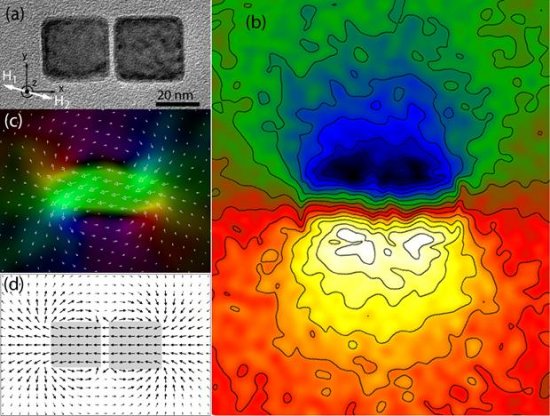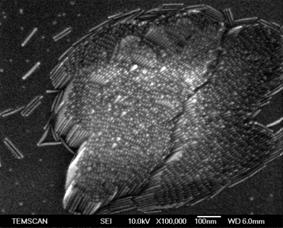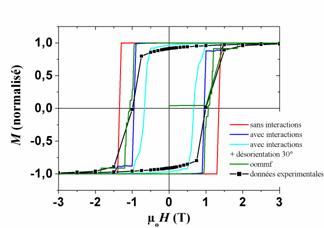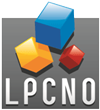Magnetism of nano-objects
Our activities are focused on the study of size reduction effects on magnetic properties, such as spin and orbital contributions, anisotropy, and ordering temperature by measurements of magnetization, ferromagnetic resonance, XMCD, Mössbauer. These properties are strongly correlated to the crystalline structure, and the shape and chemistry of surface. We study transition metals (Mn, Fe, Co, Ni) and bimetallic systems 3d/3d (FeNi, FeCo), 3d/4d (CoRh, FeRh, …), 3d/5d (CoPt). In addition to single particle effects, we study collective properties of nanoparticles self-assembled in 2D/3D super–arrays. These various objects are synthesized by the “nanostructure and organometallic chemistry” team of the LPCNO or at the Laboratoire de Chimie de Corrdination, Toulouse. Their structural properties are studied by the chemistes themselves, or in collaboration with the CEMES or inside our group. We study the magnetic properties of these objects in close correlation with their structural properties.

Alternative susceptibility measurements, Field-cooled /Zero-field cooled and magnetization measurements as a function of temperature allows one to determine anisotropy constants of nanoparticles, as well as thier siez distribution and their variation of magnetization with temperature. The extraction of these parameters requires a careful analysis of magnetic measurements, which is well masterized inside our group. In the case of iron-based nanoparticles, Mossbauer spectroscopy makes possible the fine analysis of the reaction mechanisms durong the synthesis and of the final composition of the synthesized nanoparticles.
Among the different techniques we used, the electron holography in transmission electron microscope (TEM) allows to map the induction of a unique magnetic sample. This technique is developped in the CEMES-CNRS laboratory by Etienne Snoeck. This work is then a collaboration between our Nanomagnetism team, the team of Nanostructures and Organo-metallic Chemistry from LPCNO and the team of Magnetic Nanomaterials in CEMES-CNRS lab.
Figure 2(a) displays an iron nanocube of 30 nm with a 2 nm thick shell layer of iron oxyde. It is consituted of monocristalline bcc iron and faceted with 100 planes. We used the three-dimensional version of the micromagnetic code OOMMF to find the equilibrium magnetic configuration in the sample. This code assumes identical parallelepipedic cells with uniform magnetization. The demagnetizing field, averaged over the cell volume, is calculated by the fast Fourier transform technique. The exchange field is derived from an exchange energy expressed as the sum of the dot products of the magnetizations of adjacent cells. Magnetization time evolution towards equilibrium complies with the Landau– Lifchitz–Gilbert equation. Our mesh size is 1×1×1 nm3, and the iron parameters are the ones of bulk: exchange constant A = 2×10−11 J/m, saturation magnetization MS = 1.72×106 A/m, A=2.1×10-11 J/m, KMC=4,8×104 J/m3 along the <100> (edges of cube). From the experimental induction map and the micromagnetic simulations we conclude that the isolated nano-cube display a vortex configuration of the magnetization. Figure 2 displays the same kind of investigation on two nanocubes spaced with 2 nm. We observe here a magnetic configuration corresponding to a magnetic dipole.


Many objects synthesized at our laboratory spontaneously self-organize during their synthesis : 3D super-lattices of FeCo nanoparticles, Fe nanocubes and nanowires of Co, for instance. When the distance between objects is smaller than their size, dipolar interactions influence radically their magnetic properties. One of our activity is to understand the collective effects related to these phenomena, from magnetic point of view as well as from an electrical point of view.


These objects are interesting for applications in the information storage on magnetic media. In particular, Co nanowires have a strong magneto-crystalline anisotropy combined with a high shape anisotropy. One of our current project is to organize these objects on a substrate, so that each nanowire could carry a single bit of information. Density as large as a ten of Tbits/inch2 could be reached. A way to achieve this goal is the growth of hybrid heterostructures combining the cluster growth by physical methods (sputtering, evaporation) followed by the introduction of the substrates in the synthesis pot. This could make possible the control of the density of these objects on a surface necessary for the constitution of a magnetic recording media.
